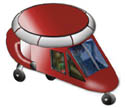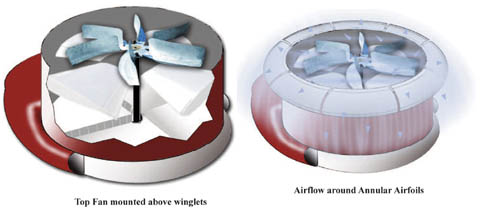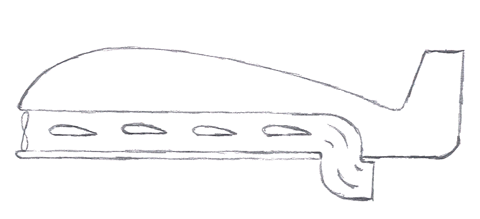Interesting Hovercraft Concept That Won't Work
 As the webmaster where I work*, I field most of the unsolicited e-mail to our company. Quite a few of those e-mails are from people who would like some help developing their concepts. Unfortunately, we're too busy developing our own concept to help others, but I still get to see some interesting ideas. Sometimes, though, it's obvious that things won't work out the way the potential inventor would like, such as the several proposals for perpetual motion machines that have been sent to me.
As the webmaster where I work*, I field most of the unsolicited e-mail to our company. Quite a few of those e-mails are from people who would like some help developing their concepts. Unfortunately, we're too busy developing our own concept to help others, but I still get to see some interesting ideas. Sometimes, though, it's obvious that things won't work out the way the potential inventor would like, such as the several proposals for perpetual motion machines that have been sent to me.
I've just received an e-mail for a hovercraft concept that looks very intriguing, but which won't actually work. For anyone who wants to test their aeronautical knowledge, go look at the concept, and see if you can figure it out yourself before reading the rest of this entry.
Vortex Aerodynamic Platform Aircraft
The basic concept is to have a blower blow air over fixed airfoils inside a chamber, then have an auxilliary fan above the airfoils to accelerate the air further, where it gets redirected by 'annular' wings and forced downward. Below are some of the images from the above link to illustrate this. I've reduced them a bit to make them fit here, so follow the link to see them full size.

I've already responded to the person who sent me the e-mail (I hate to see someone wasting their time on something doomed to failure), so I'll adapt and expand that response here.
Sometimes, it's useful to take a step back from the details, and look at the big picture. Us engineers like to look at pressures on airfoils to calculate lift, but keep in mind Newton's 3rd Law, equal and opposite reactions, and Newton's 2nd Law, F=ma. From the 3rd Law, if you want to generate a lift force, the equal and opposite reaction is a force down on the air. From the 2nd Law, a downward force on the air must be accompanied by a downward acceleration. If the air isn't accelerated downward, there is no net force down.
So, looking at this concept, the only portion generating lift is the annular airfoils that are deflecting the air downward. The fixed interior airfoils aren't generating any lift at all. As a coworker of mine puts it, it's like trying to lift yourself by your bootstraps.
Of course, it's possible to generate lift just by ducting air downward, but it's also important to keep in mind that it's much more efficient to take a big bite of air and accelerate it just a little bit, than to take a small bite of air, and accelerate it a lot. That's why the Harrier is so inefficient in hover, and why helicopters have big rotors on top. The way to get more efficient hover is to put an even bigger rotor on top.
The reason this concept struck a chord with me is that when I was younger, back before I'd studied engineering, I had a similar concept myself. A prop would blow air over interior wings to generate the lift, and a pair of side by side nozzles on the back could aim the airflow to provide thrust and yaw control. I had dreams of revolutionizing aviation with my invention.

With the simpler layout of my concept, perhaps it's easy to look at this another way to see the flaw. Right above the wings, there will be a low pressure region, lower than the pressure below the wings, so the wings themselves will be pushed upward. However, above the fuselage, the pressure will be higher than in the duct, so the fuselage will be pushed down. When you look at all of the surfaces and the pressures on them, the forces all cancel out so that there's no lift on the vehicle. In other words, since the duct is fully enclosed by the fuselage, any change in pressure in the duct only creates forces that act internally, and won't result in any net forces on the entire aircraft.
The pressure explanation is what I thought up years ago before college which led to my abandoning the concept, but I think the Newtonian explanation is easier to follow.
This idea of an inner wing airplane makes some sense given the standard explanation for how wings produce lift (the curved top surface accelerates the air, lowering the pressure). I certainly thought it would work when I was younger, and apparently, I'm not the only one that's thought of it. It's a shame that physics has to get in the way of our imaginations.
Updated 2011-04-29 - A few slight changes in wording to improve the explanation of pressure.
*It's a small company, so we all wear a lot of hats. I mostly do engineering, not website management.
I have a couple pages on the static portion of this site that are somewhat relevant to this, though not directly related:
There's a little puzzle that should be easy to answer when you think in terms of what I've described above. If a truck driver hauling chickens pulls up onto the scales at a weigh station, and discovers that his truck is overweight, if he scares the chickens into flying around inside the truck, will it change its weight?
